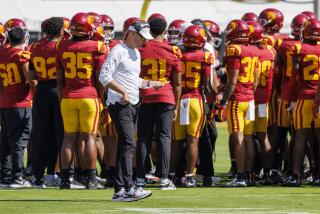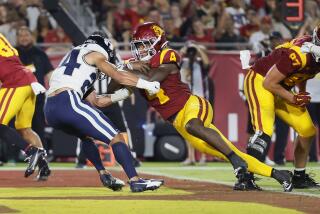Trojan Screen Saviors
- Share via
Long before he broke his first big run, there were signs that Reggie Bush was headed for a record-setting night against Fresno State.
His coaches saw it coming even before he took the field.
Two weeks earlier, USC had received videotapes of recent Fresno State games. The images were fed into a massive computer editing system and dissected into multiple variables.
Breaking down the Bulldogs in this way, Coach Pete Carroll and his staff saw a defense that stuffed runs between the tackles but faltered at the edges and became vulnerable in certain matchups.
“So it became a Reggie plan, to get him outside,” offensive coordinator Lane Kiffin said. “Those specialty runs that are Reggie-type runs.”
The strategy translated into 294 yards rushing, two touchdowns and a Pacific 10 Conference-record 513 all-purpose yards for Bush.
“Obviously,” Kiffin said, “the film is the truth.”
Like a growing number of college and professional teams, USC relies on a high-tech approach to the age-old practice of scouting opponents.
This task once required fiddling with projectors or rewinding and fast-forwarding through hours of videotape. The digital era has made for quicker, more thorough research.
A new breed of software, developed within the last decade or so, not only saves time in editing, it allows coaches to sit at their desks and, with a few clicks, retrieve highly customized information.
“You can ask for all of the defenses they ran against base personnel on third down in the second half,” Carroll said.
Teams across the country -- from Ohio State to the Denver Broncos -- have invested in this technology. At USC, the necessary array of cameras and video monitors, computers and editing stations, is crammed into an office not much larger than a walk-in closet.
Joe Schrimpl, voted by his peers as the top video coordinator in college sports last year, oversees a crew of two full-time assistants and more than a dozen student employees. Each day, they record and process video for a half-dozen of the school’s teams.
“We’re going nonstop,” Schrimpl said. “Most days it’s 10 to 12 hours minimum. Sometimes longer than that.”
When the Fresno State tapes arrived in early November, Schrimpl and his crew quickly entered them into the database so the coaches could get to work.
David Watson, an offensive line graduate assistant, looked at the Bulldog defense and Ken Norton Jr., the linebackers coach, handled offense. They cross-referenced each play by down and distance, coverage, formations and fronts.
The task took each about 10 hours, roughly half the time of editing conventional videotape. Still, Watson said, “it’s a job that requires kind of an obsessive personality. You’re making sure our coaches get the right cut-ups.”
By the start of last week, the Trojans had a virtual library on Fresno State.
That meant offensive line coach Pat Ruel could type in a request for every play in which the Bulldogs ran a particular blitz. With another click, he compiled these snippets into a video tutorial. “That allows me to find tips to give to my guys,” he said.
Players used the system too. Middle linebacker Oscar Lua said he spent about 45 minutes a day in the computer lab, studying a high-powered Bulldog offense that would amass 427 yards against the Trojans.
“You learn little things,” he said. “You might see a guy lean here or there. Or when one player is on the field, the team might have certain tendencies.”
Fresno State wasn’t the only team that got scrutinized. Each day, Schrimpl’s crew recorded USC practice from four camera positions. Runners continually brought tape back to the office, where staff entered it into the system.
By the time coaches walked off the field, the afternoon session was ready for viewing. They used the footage to evaluate their game plan and the performance of various players. They also “self-scouted” their own games from earlier this season, looking for bad habits and tendencies that Fresno State might try to exploit.
“We have the ability to break down so many things,” Ruel said. “There’s so much more that you can do now.”
Last Friday, with the game plan set, Carroll spoke with Bush in his office.
“You’re going to get a lot of chances in this game because this is the way the plan has come down,” the coach told his tailback. “Don’t force it. Don’t think that you have to do too much. It’s going to come to you, hopefully.”
The next night, it did. Bush ripped off one big gain after another and, even after he fumbled a kick return allowing Fresno State to take the lead in the fourth quarter, USC went right back to him.
With time running down, Matt Leinart recognized one of those mismatches. The Bulldog defense was covering Bush with a linebacker, so the quarterback audibled to a pass play.
Bush sailed past the defender for a 43-yard reception that set up the game-winning touchdown.
“We tried to do some different things, bouncing him outside, getting him in some space to be able to use his speed,” Kiffin said. “It was what they were giving us on film.”
*
(BEGIN TEXT OF INFOBOX)
Roll models
Where USC’s high-powered offense ranks among NCAA Division I-A schools:
*--* Category No. Rank Total offense 571.3 1st Scoring offense 48.6 2nd Yards rushing 249.2 5th Yards passing 322.1 5th
*--*
More to Read
Fight on! Are you a true Trojans fan?
Get our Times of Troy newsletter for USC insights, news and much more.
You may occasionally receive promotional content from the Los Angeles Times.







